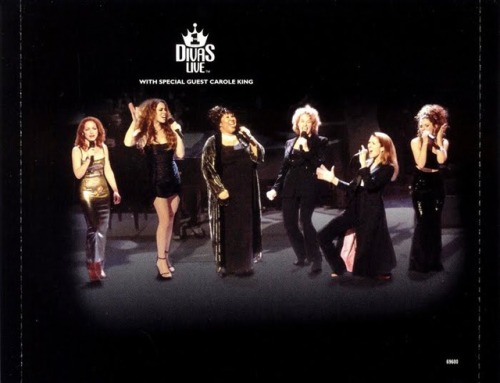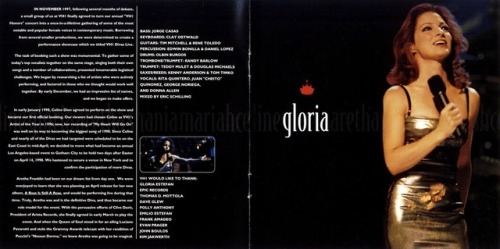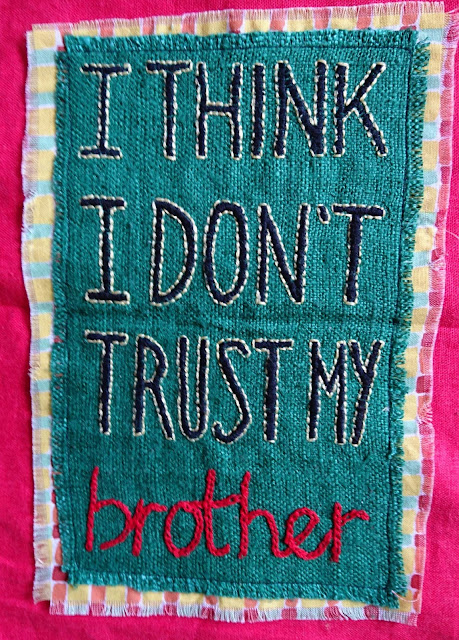
Shared posts
Jenny Slate And Chris Evans Got All Flirty On Twitter
allieYAY

Ugh, Chris Evans and Jenny Slate are like the grownup Hollywood version of that annoying couple in high school who live for the drama of breaking up and getting back together. She’s the president of the Drama Club and plays the clarinet in band but somehow hooked up with the captain of the Lacrosse team. Nobody in school really cares but they feel like their public makeups and breakups are the fuel that ignites a thousand spirit rallies. Even though they are not currently dating, Chris and Jenny still want their collective names on the lips of every Becky, Chad and Jermajesty (yes, Jermaine Jackson’s kid goes to my imaginary high school). But instead passing notes in class, they #tooktotwitter with their hijinks.
According to People:
The former couple exchanged a few flirty messages on social media over the weekend. It all started when Evans, 36, wrote about his conflicting feelings over the theme song to the popular television show Mash.
Got your barf bags ready, class?
"Probably haven't"???? Cmon, Christopher. Have you done your homework or haven't you? It's 7pm and you've had the whoooole weekend. Cmon.
— jenny slate (@jennyslate) October 21, 2017
We get it, Jenny. In drama club you “yes and” but the entire school does not need to hear you guys giggling loudly while Mr. Hand is trying to lecture about The Cuban Missile Crisis. Besides, didn’t you two break up like three times last week? I was honestly more charmed when Chris was Twitter flirting with David Duke.
And they were just getting warmed up!
How's your handwriting? Can you write me a note? Let's cut class!
— Chris Evans (@ChrisEvans) October 22, 2017
This is terrifying and exhilarating. Meet me behind the gym after science. I have shark bites.
— jenny slate (@jennyslate) October 22, 2017
So.Much.Play.Acting. I guess they feel like the world is their stage! People says:
The flirty exchange comes after the two were spotted grabbing dinner together in Atlanta. Slate joined Evans and a few of his Avengers castmates for a night out at Better Half restaurant.
Jenny may want to note that People also says that “Chris has been seen with various women in Atlanta during filming.” Burn! Will Jenny run to the bathroom and have a loud, messy fake cry or will she play it cool and ice Chris out at homecoming? Be sure to follow them both on Twitter to find out!
Pic: Instagram
Kate Winslet Doesn’t Want To Talk About Woody Allen Right Now
alliedude, fuck this

Kate Winslet has been very vocal about the Harvey Weinstein allegations. She released a statement calling his behavior “disgraceful and appalling,” which was followed by an interview explaining why she absolutely refused to thank him in her Best Actress speech at the 2009 Oscars. She had a lot of words for Harvey. All that talking must have hit Kate’s threshold for speaking out against high-powered alleged sexual predators in Hollywood. Because when it came time recently to talk about the allegations against Woody Allen, Kate just didn’t have the energy to get into that.
Kate talked to Variety to promote her upcoming movie, Wonder Wheel. It’s a Woody Allen movie, and working with that creep is something you can’t exactly side-step during a press tour. Except Kate kind of did. Kate explained last month to The New York Times why she chose to “think” about the allegations of child abuse that have plagued Woody for decades before agreeing to work with him. Kate said she chose to “put it to one side” and work with “the person.” During her interview with Variety, she was asked about the allegations and the backlash she has been facing for working with Woody. That conversation was just too heavy for Kate.
“Um.” [Winslet narrates her own silence.] She pauses. “It’s just a difficult discussion. I’d rather respectfully not enter it today.”
Kate was then asked about the criticism she faced after she told The New York Times that Woody provided “an extraordinary working experience.” Kate would like to leave that conversation alone too.
“I don’t read how people respond to things. We’re always as actors going to say the wrong thing. I think it’s better to respectfully step away from the discussion.”
Kate also said again that her mother, who passed away this year, was “so proud” she was working with Woody Allen.
Wonder Wheel comes out in December, and then there’s awards season. So I highly doubt this will be the last time Kate will be asked about him. It’s got to be so exhausting, constantly wiping the guilt from your conscience. Poor Kate. Variety says that Kate is getting “Oscar buzz” for Wonder Wheel, so I’m sure she’s going to work that angle to get out of talking about Woody in future interviews
Interviewer: “So Kate, there’s been a lot of backlash against…”
Kate: “Don’t care, Oscar.”
Interviewer: “Is there anything you would say to people who…”
Kate: “I said Oscar.“
And when that gets too tiring, she can answer with a picture of an Oscar with a note on top that says: “Give me this.”
Pic: Ioulex/Variety
Enjoy dome life in a Vashon geodesic
alliehate the inside, love the outside

Never lack for conversation starters
Why be square? Last century, Buckminster Fuller argued that geodesics were more efficient, and someone on Vashon Island agreed. They also added a few pragmatic tweaks when they built this dome in 1988. Ready for a practical yet unconventional lifestyle?
/cdn.vox-cdn.com/uploads/chorus_asset/file/9505625/Print_05.jpg)
Domes are great for being easier to heat and structurally strong. Good things to create a sense of security during our storms or while wondering about quakes. Domes can be tougher to furnish and decorate, though. So, they made some modifications. The dome doesn’t reach to the ground. It sits on a vertically-sided round-ish first story. Above, they let in a bit more light through a dormer that breaks the smooth curve of the roof.
Inside, they built a 2,690 square foot living space distributed across three floors. The ceilings are reminders of how high up they are.
/cdn.vox-cdn.com/uploads/chorus_asset/file/9505631/Print_13.jpg)
/cdn.vox-cdn.com/uploads/chorus_asset/file/9505639/Print_16.jpg)
/cdn.vox-cdn.com/uploads/chorus_asset/file/9505643/Print_18.jpg)
The ground floor has a flat ceiling, and looks like one enormous empty bonus room.
The main floor gets almost flat walls and ceilings, interrupted by triangles and trapezoids. It’s the cathedral ceilings in the main entrance that hint at innovative architecture. Much of the room is open and light, another handy feature in our grey winters.
Kitchen cabinets are one of the biggest accommodations to the geometry. They’re bent to fit the exterior wall, and wrap around the cook for a chance at a more efficient work area.
/cdn.vox-cdn.com/uploads/chorus_asset/file/9505651/Print_27.jpg)
/cdn.vox-cdn.com/uploads/chorus_asset/file/9505657/Print_24.jpg)
/cdn.vox-cdn.com/uploads/chorus_asset/file/9505659/Print_25.jpg)
The top floor sees the distinctions between walls and ceilings blend into rooms that are obviously unlike those in the majority of houses, including two bedrooms and two bathrooms. With that much square footage, the rooms can be spacious.
/cdn.vox-cdn.com/uploads/chorus_asset/file/9505677/Print_03.jpg)
/cdn.vox-cdn.com/uploads/chorus_asset/file/9505685/Print_09.jpg)
/cdn.vox-cdn.com/uploads/chorus_asset/file/9505689/Print_10.jpg)
Spacious happens outside, too. The house sits on two and a quarter naturally landscaped acres. Say hello to ferns and cedars.
The grounds also contain a 690-square-foot art studio equipped with a movable wall. Ironically, the architectural style of the creative space that’s beside the innovative dome is a fairly conventional rectangle.
Put it all together for a $585,000 listing. Retreat to the forest, or entertain guests in a voluminous home that never lacks for conversation starters.
- 13123 SW 196th St, Vashon [John L. Scott]
The Dolce & Gabbana Smeg Fridge Is Available at Neiman Marcus

For those who love the often colorful retro styling of Smeg refrigerators, they're already a work of art. However, the Italian brand partnered with Italian fashion house Dolce & Gabbana to create painted appliances more worthy of a museum than your meal prep. And now, the fridge is available at Neiman Marcus.
important announcement Rustic Modernism is steampunk for moms
important announcement
Rustic Modernism is steampunk for moms
Poser Only Able to Name 22 Guided by Voices Albums
CENTERVILLE, Ohio — Spaceboy Records clerk and “total poser” Matthew Wright was shamefully only able to name 22 of 25 studio albums by indie-rock band Guided by Voices, witnesses confirmed.
The controversy began when Wright discussed the band’s music with customer and “real” fan Mitch Kenney.
“This guy says he’s a fan, but he could only name Bee Thousand, Alien Lanes, and then another 20 more. Any idiot can do that,” Kenney said. “When this clown stumbled after only 22, I put him in his place by naming the rest. And then, I spent the next 17 minutes naming all 100 of Robert Pollard’s official album releases — he’s their lead singer and principal songwriter, in case you’re too dense to know that. But, seriously: how is that dumbo even working in a record store? He should be fired.”
Kenney claimed that the minimum requirement to be a “legitimate” Guided by Voices fan is owning all 25 studio albums, every EP, and the album of Robert Pollard’s stage banter.
“The thing people don’t seem to understand is, being a fan of a band is not about enjoying the music. It’s not about music at all,” said an increasingly irritated Kenney. “It’s about meeting very strict regulations imposed by self-appointed gatekeepers, such as myself. Only then may you call yourself a fan.”
Others disagreed with Kenney’s criteria.
Related:
- Total Poser Wears Shirt of Girl He’s Going to See
- Ancestry.com Search Reveals Local Punk Descends from Long Lineage of Posers
- Anonymous Reveals List of More Than 1000 Alleged Posers
“I don’t know if you can get into GBV unless you let GBV get into you,” said self-proclaimed superfan Erin Kendrick. “And that won’t happen until you’ve listened to at least 2,100 of Robert Pollard’s 2,500 officially released songs. Owning the albums is definitely not enough to be a fan. Whoever said that is clearly a poser and a fake GBV fan.”
Kenney eventually filed a complaint with Spaceboy Records management, who felt compelled to issue a statement of their own.
“We are aware one of our clerks could not pass a very simple musical challenge, and we will ensure he is reassigned and re-educated,” said store manager Terrence Wilson. “This is poor timing for us: just last week, we fired one of our clerks with a Black Flag tattoo when she couldn’t name every song in reverse alphabetical order. It was embarrassing, but we take full responsibility.”
Want to support The Hard Times? Pick up a shirt from our virtual merch store, click below:
Article by Patrick Coyne. Photo by Shelby Kettrick @ShelbyShootsStuff.
The post Poser Only Able to Name 22 Guided by Voices Albums
appeared first on The Hard Times.
Male Execs Pretty Sure Assault’s Not a Problem in Fashion
allieWOW COOL

A ‘WWD’ article on the topic failed to include any thoughts from women.
This story originally appeared in Racked’s daily newsletter. Want more news from Racked? Sign up for our newsletter here.
Every industry is examining its own role in turning a blind eye to its particular Harvey Weinsteins, and fashion is no exception. On Wednesday, Women’s Wear Daily published a story about sexual harassment in the fashion industry as it related to advertising, specifically discussing what it’s like on set during photo shoots. The story quotes only male executives.
One after the other, each said they’d never witnessed sexual harassment, assault, or abuse on set. For example, “We did crazy antics to get crazy pictures, but never abused anybody.” Collectively, the men conclude that fashion doesn’t have the same problem as, say, Hollywood or Silicon Valley.
The story is full of quotes like “I don’t think anything happened and we were worried about one thing — do great pictures” and “I was under the opinion that all these things had gotten better.” One executive said that he walked in on a model having sex with fashion photographer Terry Richardson, against whom a laundry list of accusations has been leveled, but didn’t think anything of it because “I don’t know what the relationship was.” Another mentioned that he’s hired “abusive stylists,” but clarified: “Sexually abusive? Maybe emotionally abusive. They take it out on the girls and guys and they took it out on me. I always embraced that banter back and forth. The best ones really believed in what they were doing.”
At the top, the piece mentions that activist and model Cameron Russell invited those in her industry to share their stories via Instagram; following hundreds of replies, Russell has spent the last week sharing screenshots of the responses on her account, while women at large have been encouraged to speak out about their own experiences using the hashtag #MeToo. Regardless of what it was meant to do — WWD declined to provide a comment to Racked — this piece reads like a less-than-thoughtful response from the industry’s obviously naive male contingent. The paper, which has long covered and championed a female-driven industry, does not even challenge the anecdotes. The Richardson one, for example, is followed by this quote: “Terry never abused anybody when I worked with him.” Countless women have repeatedly accused the photographer of assault.
Choosing to cover sexual assault and not include the voices of women adds further fuel to this ongoing problem. As advertising executive Cindy Gallop tweeted, “all-male interviews = biggest reinforcement sexual harassment is rife.”
Fire burns southwest of San Jose in Santa Cruz Mountains (updated)
alliewelp, this one is close to me. ugh.

Evacuation orders are in place for Deer Creek Road, Rons Road, Dons Road, Lost Valley Road, Favre Ridge, and Oak Ridge
Update, October 19: The Bear Fire has grown to 320 acres. Crews have increased containment to 30 percent, as of Thursday afternoon, reports KSBW.
San Jose Mercury News reports that some evacuation orders have been lifted for the Bear Fire. “Residents can go back to the Las Cumbres and Skyline Boulevard communities, as well as areas south of Bear Creek Road.”
***
Update, October 18: Cal Fire reports that roughly 600 firefighters, 52 engines, and nine helicopters are responding to the Bear Fire in the Santa Cruz Mountains. But at 9 p.m. Tuesday evening, the blaze was only five percent contained and grew to more than 270 acres.
The latest Cal Fire update says:
The fire is burning in steep, inaccessible terrain covered by drought stressed fuels in heavy timber. [...] Tonight, firefighters will continue to put in containment lines. Tomorrow morning, little change is anticipated in humidity and winds are predicted to remain light, from two to five MPH, increasing from the west by evening.
Evacuation orders are in place for Bear Creek Road, Deer Creek, and Las Cumbres, with Lakeside Elementary School and Zayante Fire Station still serving as evacuation centers. (See below for both locations.)
Those with animals to evacuate should take livestock and other large animals to the Graham Hill Showgrounds, 1145 Graham Hill Road, Santa Cruz, and smaller animals can go to Santa Cruz County Animal Services: 2200 Seventh Avenue, Santa Cruz.
***
As the tide turns on the nearly two dozen existing Northern California fires, with Cal Fire’s latest fire map showing greater containment on blazes in Napa and Sonoma Counties and beyond, a new conflagration appeared Monday evening in the Santa Cruz mountains.
Tuesday morning Cal Fire reported via Twitter, that “firefighters are battling a 125 acre fire off Bear Creek road, southwest of San Jose.”
The agency places the burn less than six miles southwest of Los Gatos. Between 100 and 150 people living throughout the Santa Cruz Mountains evacuated in the middle of the night, fleeing what one witness called “a literal wall of fire.”
Cal Fire says a rescue operation is underway at the #BearFire in the Santa Cruz Mountains. A firefighter fell down a ravine. pic.twitter.com/ina6yj1rkF
— Matt Keller (@MattKellerABC7) October 17, 2017
According to NBC Bay Area, “Evacuation orders are in place for Deer Creek Road, Rons Road, Dons Road, Lost Valley Road, Favre Ridge, and Oak Ridge.”
Residents unsure whether or not current evacuation orders cover their home can text their ZIP code to 888777 to receive regular updates on fire conditions.
The San Francisco Chronicle reports that evacuation centers are open in at Lakeside Elementary School in Los Gatos and at the Zayante Fire Station in Felton.
Do not ignore evacuation orders, even if you don’t think that your home is in any danger.
According to KTVU, the Bear Fire has already injured five firefighters and burned one home, with several fire crew members suffering from smoke inhalation while another fell 50 feet into a ravine and broke his wrist. During the night, racing flames threatened some 150 homes.
Another fire had previously broken out near Monterey and Carmel over the weekend but was swiftly contained at 31 acres. Firefighters tamed a 73-acre fire near Lake San Antonio in immediate fashion as well, and a 58-acre blaze west of Fresno.
#BREAKING: Fire in Santa Cruz Mountains forces evacuations #BearFire https://t.co/zDTNE8gZvJ pic.twitter.com/HrsmRXVWSK
— Julianne Herrera (@JulestheFirst26) October 17, 2017
- Bear Fire [Cal Fire]
- Wall Of Fire Blazes [NBC Bay Area]
- Santa Cruz Mountains Evacuated [Chronicle]
- New Fire Evacuations In Santa Cruz [KTVU]
Looking Around: On Moving; or, The Story of a Little Old House
allieTHIS IS SO COOL
Author’s Note: This article consisted of two weeks of intense research, involving scouring over fire insurance maps, tables of wages, census records, Sears catalogs, and atlases. Before I begin, I owe some mad thanks to those who helped provide their resources and advice: preservationist Jackson Gilman-Forlini, furniture history guru Susannah Wagner, the nice folks from the Maryland Historical Society, and the research library staff at the Johns Hopkins University.
Anyone who has made copious trips to U-Haul, rendered their fingertips numb after stringing along line after line of packing tape, or spent hours intimately acquainting ones lower back with an ice pack, knows – and loathes – moving.

Moving is stressful. It is a form of migration, itself an immense change. Despite the momentous effect moving has on us, there is little to be found regarding the history of, well, moving. Plenty has been said about techniques of migration, by boat, by horse and buggy, by rail, and by car.
In novels and movies, from Harry Potter to Doctor Zhivago, there are scenes of train stations, carts with ornamented trunks, and porters donning funny cylindrical hats to haul them. In photographs of Ellis Island complete with their visual narratives of the American Dream, we see thousands of hopeful newcomers cheering gleefully, suitcases in hand.
As time goes by, the railway porters are replaced with truck drivers; the journey implied by the ocean liner morphs into bucolic images of a smiling suburban family on the island-lawn of their poorly-shuttered idyll.
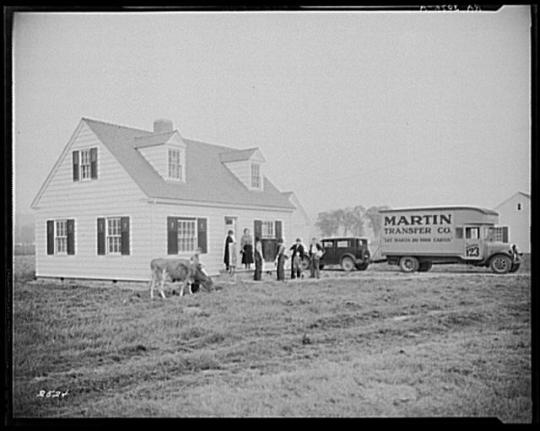
Family Moving to their New Home. Washington State, 1935. via Library of Congress.
Why am I writing about moving? Over the last two weeks or so, I, myself, moved. I moved from a dingy (yet immensely charming) self-constructed room in what used to be a Cork and Seal Factory, to a little 812 square-foot Baltimore rowhouse.
Each of the times I’ve moved from apartment to apartment (and finally, on this move, to an actual, full-sized house), there have been great difficulties loading and unloading all of my crap – difficulties innate to the houses themselves. These were usually small hardships, involving the clever rotation of a sofa or armchair in order to wrestle it out the door.
This time, however, I came to a horrifying revelation: None of my existing furniture would be able to A.) fit within the cramped dimensions of the narrow staircase or B.) make it around the corner in the shallow hallway to my room.
I solved my problem the same way as any reasonable millennial:

Photo by Rainchill. (CC BY-3.0)
Yet, as I loaded up my cart with brown box after brown box, I couldn’t help but wonder: What did people do before Ikea? Why were the stairs so narrow, and more so, what went up them before my trendy flat-packed furniture?
The Little Rowhouse
According to two days of scouring archival newspapers and other primary sources, I could gleam a few interesting things about the little brown rowhouse into which I’m currently schlepping my stuff.

The Little Brown Rowhouse (center). Via Google Maps.
The rowhouse was built sometime between 1900 and 1902. A Baltimore Sun record from 1898 shows the auction of parcels of land where the house would soon be built:

EDIT: My colleague, Jackson, has found out that the house was built by a pair of builders named John S. Kidd & William A. Davidson.
However, the first mention of any of the houses on the row (that is to say, even-numbered houses, as the houses on the opposite side of the street are of a different design), comes later, in 1902, in a divorce notice:

In 1905, the house next door to mine was for lease:

Unfortunately, no searches for C.W. Webb pulled up anything of note.
I learned some other interesting things during my newspaper dig, (most notably that the folks who once lived a block south from me got busted during Prohibition) - but ultimately, came to a dead end on my original topic: what kind of person moved into my rowhouse first, and how they did it.
The Process
In order to glean how working people moved back in the early 1900s, I decided to focus on a few key areas of research:
- What kind of wages the family would make, what they would spend it on and what kind of local industry they might have participated in.
- What kind of stuff was being moved; (AKA what kind of furniture these folks bought and how much it cost)
- What the costs were of moving services during this time, and whether they were affordable for the family in question.
Potential Jobs, Wages, and Expenditures
The best way to look for what kind of industry existed in a certain area at a certain time is through a series of maps by the Sanborn Fire Insurance Co. These maps were used for evaluating fire risk (and therefore how high the premiums should be for fire insurance.)
In the index of a Sanborn Map, there are two parts. First is the list of streets, with a number, corresponding to a plate number. The second is a list of industries along with larger businesses, schools, orphanages, and churches, along with their plate numbers. To find out what kind of industry was near the street you’re looking for, simply look for industries relatively close to the plate number of your street.

It’s likely that the folks who lived in my house worked in one of two places: as a railworker (at the Maryland & Pennsylvania Railroad, The Baltimore & Ohio Railroad; The United Railroad & Electric Company) or in the stone quarry (Sisson Marble Works, not shown in screenshot). Working class women often worked as well, most likely in the nearby textile mills lining the Jones Falls River.
There are a few smaller industries these folks could have worked in as well, such as the Columbia Motor & Manufacturing Co., The American Can Factory, J. Stack & Sons Lumber, or the Schier & Bros. Dairy. However, it’s most likely that the person who first lived in my house was a stone or rail worker, as the house used to be mere blocks from both the quarry and a massive rail yard:

Image from a 1905 Map. House is in top-right corner, in red.
Okay, so we know where the head of the household likely worked. How much did they make doing it?
Were the head of household a worker in the nearby marble quarry, he (women did not work in the quarry in 1900) would have made around $813 a year.

Source: https://catalog.hathitrust.org/Record/008319974
Were they a railworker of some sort (the average workweek of railway workers in nearby Pennsylvania was around 62 hours/week in 1901) they would have made somewhere between $420/year as a day laborer and $1350/year as a senior engineer. Source.
What would these folks spend these wages on? Here are some more statistics (average expenditures) from Pennsylvania (a neighboring state with similar industries.)

Now that we know what these folks might have made (on average), let’s see what kind of goods they possibly purchased.
Furniture
It’s difficult to know what kind of furniture most working class folks had in their houses. According to my sister (Hi Suz!), who studies furniture history at the University of North Carolina School of the Arts, it’s possible that a family working in 1900 bought some pieces of mass-produced furniture, like that sold by Sears Roebuck & Co.

Page from a Sears catalog c. 1900.
The truth is more difficult, because much of the mass-produced, inexpensive furniture of the time was made out of cheap materials such as basswood and has not survived. It’s also possible that the family had some pieces passed down from generation to generation, which wouldn’t be accounted for in primary sources from the time. What is true, is that there is a certain amount of furniture most folks need for their homes.
Fortunately for us, there are photographs in the Library of Congress of tenement and other working class interiors, enabling us to get a better picture of what folks had in their homes:
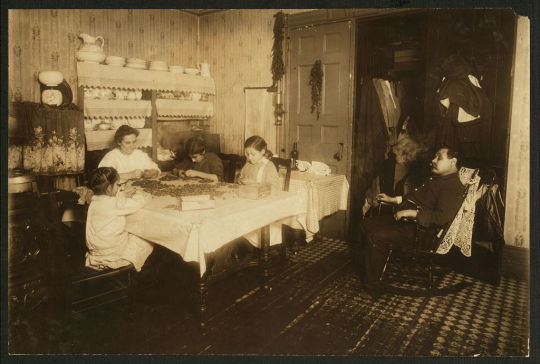
Kitchen of a Railway Worker. New York, 1911. Library of Congress.
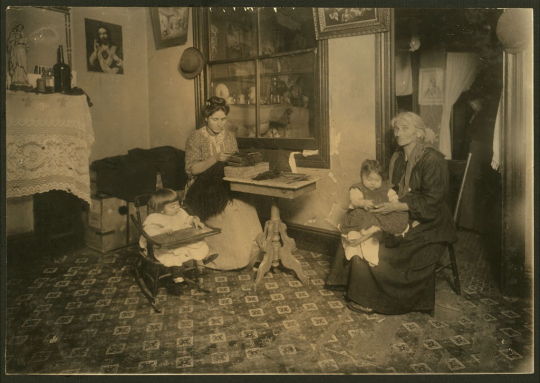
Living area of a NYC Tenement. 1912. Library of Congress.
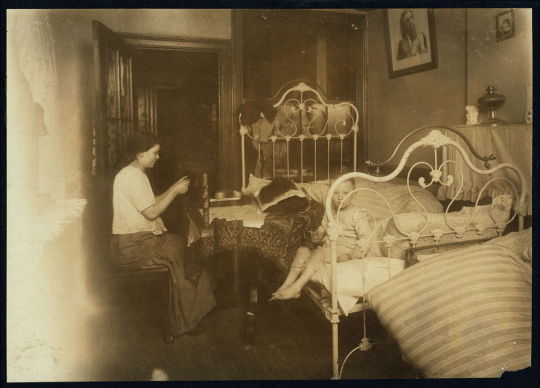
Small interior bedroom of a tenement. NYC, 1912. Library of Congress.
Descriptions of working class housing from the book Working Class Life: The “American Standard” in Comparative Perspective, show some common similarities between how working class homes were furnished; the most important being that average expenditure on furniture rose when folks were paid more. Often, according to the book, almost $13 per year was spent simply replacing cheap linens, curtains, and cutlery alone, so there was little room left over for additional pieces. (204)
Typically, there was a shared living and dining room, centered around a table, surrounded by Windsor or ladder backed chairs, perhaps a sofa and chest-of-drawers, a few trinkets and photographs, and perhaps a rug.

Most of the time, upstairs rooms were almost unfurnished, having only an iron bed frame and felt mattress.
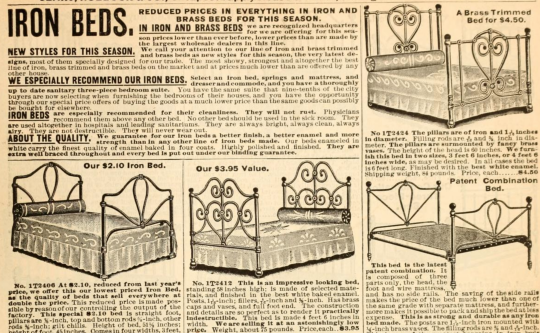

Those who made a little extra had more frills: a rocking chair and china cabinet in the front room, and in the bedrooms, mirrors, and bathroom fixtures like chamberpots and washbasins. (203)
This description perfectly coincides with the Baltimore rowhouse, which has two bedrooms, a kitchen, a living room, and a basement (likely unfinished until much later). The bathroom, like most bathrooms in dwellings built before 1910, was a more recent addition. Therefore, It’s likely that the folks who first lived in the little rowhouse had furniture and rooms like those described above.
Which brings us back to…
Moving
As far as the answer to the initial question of “how stuff got up the stairs”, the answer is that, frankly, not that much had to go up the stairs in the first place.
Most mass-produced iron beds could be dismantled and taken upstairs in parts. Felt mattresses were extraordinarily thin by todays standards, and, because they’re stuffed and pliable, the family would have little trouble navigating the tricky corner at the top of the stairs. As for the more luxurious items, mirrors, basins, and chamberpots, all are also easily portable.

The answer to the second question, which was how would a family move from one home to another is, sadly, we’re still not sure. What is certain is that, if they came from another city, they probably didn’t take much with them, as shipping or transferring things by train was extraordinarily expensive by working class standards: the Pennsylvania railroad charged 75¢ per piece (not counting oversized items) - to move one item alone was about a full day’s work for a common day laborer.
If the family were moving within the city, it’s highly unlikely they used a moving company, as the prices for such were hefty as well at 25¢/piece, as advertised in 1898 by this local furniture mover:

A local anonymous opinion from 1904 corroborates this price range, bemoaning the techniques the moving company used to transfer items:

What’s more likely is that the family either had some way of bringing what existing furniture they had to the new house (usually by horse & buggy in 1900) or they bought furniture either by local/national catalog, secondhand or from one of the myriad small dealers or manufacturers in the city itself, seen here in the 1905-1906 edition of Polk’s Business Directory:
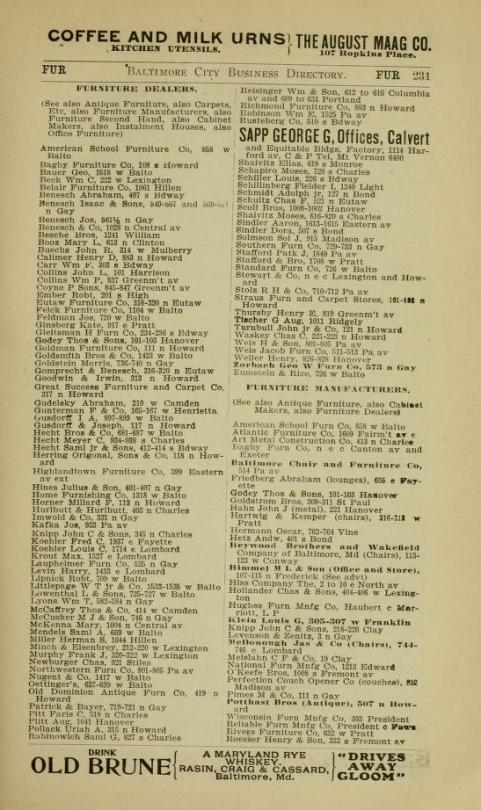
As it turns out, the folks who first moved into this house did so in a way not that different from me. They probably called up some folks to help haul what they could (if they were moving within the city) and what they couldn’t, they bought.
Besides, what’s Sears if not the Ikea of the past?
If you like this post, and want to see more like it, consider supporting me on Patreon! Also JUST A HEADS UP - I’ve started posting a GOOD HOUSE built since 1980 from the area where I picked this week’s McMansion as bonus content on Patreon!
Not into small donations and sick bonus content? Check out the McMansion Hell Store ! 100% of the proceeds from the McMansion Hell store will go to help victims of the recent hurricanes.
Copyright Disclaimer: All photographs are used in this post under fair use for the purposes of education, satire, and parody, consistent with 17 USC §107. Manipulated photos are considered derivative work and are Copyright © 2017 McMansion Hell. Please email kate@mcmansionhell.com before using these images on another site. (am v chill about this)
I Sure Hope ‘Beetlejuice’ Bangs Are Having a Moment

Winona forever.
This story originally appeared in Racked’s daily newsletter. Want more news from Racked? Sign up for our newsletter here.
The spooky month of October started in September, when Dior styled one of its Paris Fashion Week models in an outfit that, as Steff Yotka of Vogue.com accurately pointed out, looked a lot like something Beetlejuice’s goth teen Lydia Deetz would wear (if the skirt were a few feet longer, of course). It wasn’t just because of the model’s black and white socks or the decorative spider at her throat, but her dark baby bangs, clumped together into little spikes beneath a wide-brimmed hat.
/cdn.vox-cdn.com/uploads/chorus_asset/file/9400581/Beetlejuice_Winona_Ryder.jpg)
The festivities continued yesterday when model-slash-actress Cara Delevingne showed up to a book signing for her first YA novel, Mirror, Mirror — because she does that, too — with short bangs brushed forward to similar, pointy effect. (In addition to making her literary debut last night, Delevingne publicly returned to being a brunette after a platinum-blonde hiatus.)
/cdn.vox-cdn.com/uploads/chorus_asset/file/9400543/GettyImages_857535848.jpg) Photo: Tristan Fewings/Getty Images
Photo: Tristan Fewings/Getty Images
Collectively, this is a nice warm-up to the coming weeks of Halloween parties, which, statistically, have at least two Lydia Deetzes in the same room at any time.
Alleged bomb-threat-making cyberstalker was a horrible person in high school and college, too, investigators say
alliejesus fucking christ
A man determined to torment a former roommate in Watertown used skills gained as a computer-science major and a professional software writer - along with some basic human engineering - to repeatedly target the woman, her family, her friends and her colleagues with sexually explicit messages, bomb threats to institutions in Waltham and Chelmsford made in their names, for some 18 months until his arrest last week, according to an affidavit by an FBI agent on the case.
Ryan Lin, 24, currently faces one charge of cyberstalking. But the affidavit suggests the possibility of additional charges - for example, for possession of the child pornography Lin allegedly used as part of his online harassment campaign, and for the bomb threats.
And the affidavit leaves open the possibility other people could be charged - Lin allegedly posted the woman's person information on a well known "doxxing" site, where additional people may have used it to harass her.
Officials charge that starting in April, 2016, Lin not only sent the woman and her acquaintances harassing messages but stuck her name on bomb threats to schools and institutions that included Brandeis and Bentley universities, the Waltham Public Library, public and private schools and daycare centers in Waltham, and public schools in Chelmsford.
He allegedly and repeatedly sent messages in her name and purporting to describe her sexual desires - including with children at one point - to acquaintances of her family members. He also revealed personal information she had never told anybody about - except her personal journal, stored on Google Docs.
In one case, he managed to find and contact somebody who had hired the woman to dog sit - allegedly telling her the woman had killed her dog. That brought Weston Police racing to the person's house - where they found the dog OK. In another case, he allegedly posted her alleged rape and BDSM desires on a fetish site that led to at least three men simply showing up at her new home looking for her.
Lin tried to hide his tracks through extensive use of various anonymizing networks and techniques to hide his IP address - such as the use of VPNs and the anonymizing TOR network, but he also used simpler techniques to gain access to the woman's diary and photos. These included simply walking into her unlocked room when they shared a Watertown apartment with two other people and turning on her un-password-protected laptop, the affidavit says.
The harassment proved so unrelenting the woman finally moved out of Massachusets altogether, officials say.
As they were following the digital footsteps that Lin proved unable to hide - such as his browser history on his former work computer and information from at least one of the VPN providers he allegedly used - investigators were also talking to people who knew him, going back to his days in high school in Connecticut, where several of his classmates told Waltham detectives that he forged Facebook pages in their names and sexually harassed female students, the affidavit states.
At Rensselaer Polytechnic Institute, where Lin majored in computer science, two other students went to court to try to get him to leave them alone and stop impersonating them, the affidavit says, adding one also charged him with e-mailing her rape threats.
Before he moved in with the woman and the other two roommates - whom he had contacted via a Craigslist ad - he threatened to kill his previous roommate, the affidavit alleges. And while he reserved his ire for the woman, he also worried the other two people: He'd leave half-eaten food in closets and once smeared mayonnaise on the living-room floor as part of "redecorating," the affidavit states.
Innocent, etc.
Brighton cat cafe seems to have used up all nine of its lives before it even opened
alliechrist, what an asshole
A cat cafe that was supposed to open on Chestnut Hill Avenue in Brighton last month now looks set to never open at all.
In a post today, Purr Cat Cafe owner Diane Kelly writes:
Boston.
Clearly there is no interest in Cat Cafe here.
No Meow. Meow. PURR for Boston.
Last December, the Zoning Board of Appeals approved what would have been Boston's first cat cafe, where patrons could reserve time to just sit in a chair petting cats - sipping, if they wanted, coffee ordered in from a nearby cafe.
But Kelly has been openly feuding with area cat lovers for weeks now over the condition of the basement where cats would stay while the cafe was closed for the night. Two people she hired to run the cafe quit. The adoption agency that was going to supply cats for patrons to pet - and possibly adopt - pulled out. Things got ugly.
H/t Marc Hurwitz.
THE SECRETS QUILT
Watch: The powerful new documentary on living with chronic fatigue syndrome
Jen Brea was a 28-year-old grad student when her health began to deteriorate after a high fever. As she suffered from recurrent infections, profound dizziness that left her unable to stand, and eventually terrifying neurological symptoms, doctors told her that she was stressed, or just dehydrated, and finally that a repressed trauma was the source of all her ailments.
Eventually, Brea was diagnosed with myalgic encephalomyelitis, more commonly known as chronic fatigue syndrome in the US. And now her documentary on the disease—which she directed mostly via Skype since she’s been bed-ridden for much of the last six years—is coming to select theaters.
I interviewed Brea and include her story in my forthcoming book on gender bias in medicine. It’s estimated that one million people in the US—and 17 million worldwide—have ME/CFS. Over 80 percent of them are women, and sexism played a large role in the public and the medical system’s reception to the disease.
In the US, the condition first came on the radar after a large outbreak near Lake Tahoe in the mid-eighties. But, unable to figure out the underlying cause, the medical community quickly suspected it of being nothing more than the psychogenic symptoms of neurotic women. The media derided it as “yuppie flu,” its sufferers stereotyped as burnt-out “educated white women.” (In reality, the disease, like many health problems, disproportionately affects low-income patients and people of color.) Meanwhile, myalgic encephalomyelitis, a name given to sporadic outbreaks of a similar-sounding illness that had occurred throughout the first half of the twentieth century, had already begun to be reframed as cases of “mass hysteria” on the basis that it was mostly women who were impacted.
Unrest, which tells Brea’s story, as well as the stories of a few other ME/CFS patients from around the world, discusses this history of neglect by the medical system for the last thirty years. After all, Brea is also an advocate. She co-founded #MEAction, a platform for ME/CFS advocacy efforts, that organized the Millions Missing protests to demand more funding for research on the disease (there has been unbelievably little) and recognition for the millions of patients affected by it (many health care providers continue to believe it’s largely a psychiatric condition).
The film itself isn’t heavy-handed or preachy though. It simply lays bare what life is actually like for severely ill ME/CFS patients. Brea initially began an iPhone video diary with no intention of turning it into a documentary; it was just an outlet for herself when she could no longer read or write. So much of the footage is extremely raw and painful. The film is rooted in a faith that if people truly understood what the disease did to its sufferers, it couldn’t possibly continue to be dismissed and minimized. As such, Unrest‘s greatest potential will come if people beyond those affected, directly or indirectly, by ME/CFS see it—especially those in the medical community who too often belittle it and those in the media who too often uncritically accept some of the bad science that’s been done on it.
So see it and also help spread the the word. While Unrest tells the very particular story of ME/CFS, the film will no doubt resonate with any woman who has ever had a doctor dismiss her symptoms as “stress” or who suffers from other poorly understood conditions that disproportionately affect women and have been similarly neglected—like fibromyalgia, interstitial cystitis, vulvodynia, to name a few. Which, sadly, is a whole lot of us.
If you’re in the NYC area, you can see Unrest at IFC this weekend. San Francisco, Chicago, Los Angeles—you’ll have a chance the following one. See all upcoming screenings here.
Bonus viewing: Check out Brea’s great TED Talk too.
San Francisco’s coolest ride: Homobiles offers safe rides for the queer community

Pre-Uber ride service gets LGBTQIQ people around the city
Will the driver be cool? Will the driver be homophobic? Will the driver try to kill me? These are questions that pass through the minds of many kings and queens nightly as they make their way to and from nightclubs.
Buses, taxis, ride-hailing, and subways have proven unsafe modes of transportation for out queer people living in the city, especially come nightfall. For many LGBTIQ ilk, Muni and BART are ripe for ignorance after the bars close. Meanwhile, hailing an Uber or cab dressed in full drag is never a sure bet.
Whether it's discrimination based on appearance, gender identity, or regalia, queer riders (especially females) face bigger challengers when taking traditional forms of transportation.
/cdn.vox-cdn.com/uploads/chorus_asset/file/9285967/03_Wednesday_Coolest_SF_1.jpg)
Which is why, prior to the advent of Uber or Lyft, Lynnee Breedlove conceived Homobiles, a nonprofit providing safe transit to San Francisco’s LGBTIQ community. She founded it in 2010 after she drove lesbian friends to a conference. (The outfit also caters to black people living in Bayview and Hunters Point, who are often stranded by taxis and ride-hailing services.)
"All of a sudden the butches and trans guys who saw me wanted to drive, and all the babes and drag queens wanted rides, and then I realized that this was a serious need that had to be filled,” Breedlove told Buzzfeed in 2014.
My ride with the pre-Kalanick service started via text. Giving them my name, address, drop off, and time of pick up was all I needed.
/cdn.vox-cdn.com/uploads/chorus_asset/file/9288023/IMG_9999.jpg)
Janet, a New York native living in San Francisco for 20 years, picked me at home in SoMa, whisking me to the Marina.
Friendly, informative, and—above all—an excellent driver, Janet told me how the service works, payment-wise: The suggested amount is $1 per minute, but no one is refused service due to lack of funds. The amount to SFO from the city is a suggested $35.
“But if you don’t have any money, we usually just give you a free ride,” says Janet.
During our ride, we talked about the city and how much it has changed over the last few years. Many more cars on the road than ever before. A different population than a decade ago. Out of control rents pushing dispossessed people out of the city.
We even discussed Bette Midler (Janet’s favorite artist of all time) and her recent Tony win. In a perfect world, talk of the Divine Miss M and Tonys would be mandatory in all cab rides.
From Janet’s windshield hung a wooden peace sign and a set of pride rings, fruit loops, as they were called back in the day.
“These rings are older than most of my riders now,” she says.
Arriving at my destination, I gladly handed over some cash. (Passengers can also use a credit card to pay.) It was the perfect ride, at least for me. In a city rife with driverless cars using city streets as testing grounds or Uber drivers threatening passengers with rape, it warms the heart to know that at least one company is trying to take care of San Franciscans.
Birthday Sluts

Fiona Apple (40)
Niall Horan (24)
Ben Savage (37)
Swizz Beatz (39)
Puma Swede (41)
Joe Don Rooney (42)
Stella McCartney (46)
Tyler Perry (48)
Michelle Duggar (51)
Annie Duke (52)
Jeff Ross (52)
Tavis Smiley (53)
Dave Mustaine (56)
Geri Jewell (61)
Iyanla Vanzant (64)
Randy Jones (65)
Jean Smart (66)
Frank Marshall (71)
Jacqueline Bisset (73)
Peter Cetera (73)
Joe E. Tata (81)
Roald Dahl (1916-1990)
Pic: Pinterest




